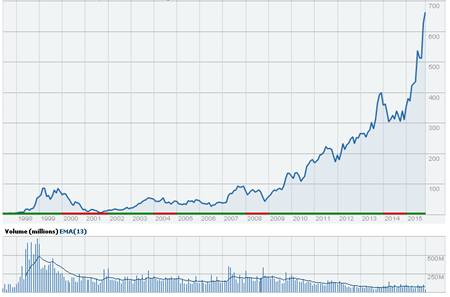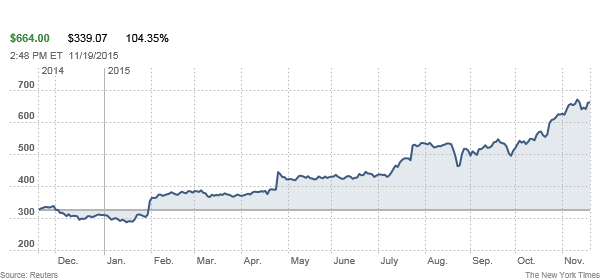
Technology
How Amazon’s Long
Game Yielded a Retail Juggernaut

Parcel delivery in Battery
Park City in New York. One analyst predicts that in five years, 50 percent
of American households will have joined Amazon Prime.
Credit Ángel Franco/The New
York Times |
To study
the graph of Amazon’s stock performance in 2015
is to witness a series of stepwise lurches toward commanding new heights. Over
all, the stock market has been flat this year, and technology companies, as a
group,
haven’t fared much better.
Then there’s
Amazon, which slipped the atmosphere.
Shares of
Jeff Bezos’s company have doubled in value
so far in 2015, pushing
Amazon into the world’s 10 largest
companies by stock market value, where it jockeys for position with General
Electric and is far ahead of Walmart.
There is a
simple explanation for Amazon’s rise, and also a second, more complicated one.
The simple story involves Amazon Web Services, the company’s cloud-computing
business, which rents out vast amounts of server space to other companies.
Amazon began disclosing A.W.S.’s financial performance in April, and the numbers
showed that selling server space was a much bigger business than anyone had
realized.
Deutsche Bank estimates that A.W.S., which
is less than a decade old, could soon be worth $160 billion as a stand-alone
company. That’s more valuable than Intel.
Yet the
disclosure of A.W.S.’s size has obscured a deeper change at Amazon. For years,
observers have wondered if Amazon’s
shopping business — you know, its main business — could ever really work.
Investors gave Mr. Bezos enormous leeway to spend billions building out a
distribution-center infrastructure, but it remained a semi-open question if the
scale and pace of investments would ever pay off. Could this company ever make a
whole lot of money selling so much for so little?
As we embark
upon another holiday shopping season, the answer is becoming clear: Yes, Amazon
can make money selling stuff. In the
flood of rapturous reviews from stock
analysts over
the company’s earnings report last month,
several noted that Amazon’s retail operations had reached a “critical scale” or
an “inflection point.” They meant that Amazon’s enormous investments in
infrastructure and logistics have begun to pay off. The company keeps capturing
a larger slice of American and even international purchases. It keeps attracting
more users to its Prime fast-shipping subscription program, and, albeit slowly,
it is beginning to scratch out higher profits from shoppers.
The Rapid Rise in Amazon Shares
Now that Amazon
has hit this point, it’s difficult to see how any other retailer could catch up
anytime soon. I recently asked a couple of Silicon Valley venture capitalists
who have previously made huge investments in e-commerce whether they were keen
to spend any more in the sector. They weren’t, citing Amazon.
This week I also
asked several stock analysts if they could see any potential competitive threat
to Amazon’s online sales dominance. Some literally laughed at the question.
“The truth is
they’re building a really insurmountable infrastructure that I don’t see how
others can really deal with,” said Ben Schachter, who studies Amazon for
Macquarie Securities.
It may be no exaggeration to say that at least in North America and
Europe, e-commerce as an expansive category of Internet exploration is
on the wane. Mr. Bezos has already won the game.
There are many
who will lament that Amazon has reached these heights, and not just its retail
competitors. As with Walmart before it, Amazon’s rise engenders fears of
economic and cultural totalitarianism —
which are reasonable concerns, even if
often overblown. Many critics are worried,
too,
about how the company treats its workers
(Amazon has
argued that they’re treated well) and
how it affects local and national economic activity
(a matter of constant dispute), among many other issues.
And while we’re
in the to-be-sure part of this column, let’s note that Amazon also faces a wider
set of competitive threats internationally. Although it has reported
increasingly brisk sales in India, the company has had a difficult time breaking
into the lucrative Chinese market, where Alibaba dominates the shopping scene.
Indeed,
Alibaba’s sales and profits dwarf Amazon’s. On Singles Day, held in China on
Nov. 11 to celebrate the proudly unmarried, as best as I can tell,
Alibaba rang in more than $14 billion in
sales, which is more than Americans will spend both offline and online over the
entire post-Thanksgiving weekend. (Because Alibaba’s ecommerce businesses tend
to connect buyers and sellers, its sales aren’t booked directly as revenue;
instead, it takes a cut of each purchase made on its platform.)
Even
domestically, competitors aren’t sitting idle. Over the last year, investors
have poured hundreds of millions of dollars into Jet.com,
which aims to become a discount competitor to Amazon.
The firm’s odds of success, though, have always looked long, and seem to
keep getting longer.
|

Credit
Stuart Goldenberg
|
|
Walmart, which
on Tuesday published earnings that
came in slightly above analysts’ expectations,
is also
spending billions to slow Amazon’s roll.
But Walmart said that in its latest quarter, e-commerce sales had grown only 10
percent from a year ago. Amazon’s retail sales rose 20 percent during the same
period.
Why is Amazon so
far ahead? It is difficult to resist marveling at the way Mr. Bezos has built
his indomitable shopping machine, and the very real advantages in price and
convenience that he has brought to America’s national pastime of buying stuff.
What has been key to this rise, and missing from many of his competitors’
efforts, is patience. In a very old-fashioned manner, one that is far out of
step with a corporate world in which milestones are measured every three months,
Amazon has been willing to build its empire methodically and at great cost over
almost two decades, despite skepticism from many sectors of the business world.
Now those
investments are beginning to bear fruit. It’s happening in fulfillment, which is
the business term for filling and shipping orders. Amazon has built more than
100 warehouses from which to package and ship goods, and it hasn’t really slowed
its pace in establishing more. Because the warehouses speed up Amazon’s
shipping, encouraging more shopping, the costs of these centers is becoming an
ever-smaller fraction of Amazon’s operations.
Amazon’s
investments in Prime, the $99-a-year service that offers free two-day shipping,
are also paying off. Last year
Mr. Bezos told me that people were
increasingly signing up for Prime for the company’s media offerings — the free
TV shows, music and movies that come with the subscription, and which Amazon has
been spending vast sums to produce.
Mr. Schachter,
of Macquarie Securities, estimates that there will be at least 40 million Prime
subscribers by the end of this year, and perhaps as many as 60 million, up from
an estimated 30 million at the beginning of 2015. He argued that Amazon’s
investments in giveaways will help make Prime more attractive to people in
lower-income groups. As a result, he predicted that by 2020, 50 percent of
American households will have joined Prime, “and that’s very conservative,” he
said.
Growth in Prime
subscriptions matters because Prime alters the psychology of shopping. Once
you’ve prepaid for shipping, you tend to start more of your shopping excursions
at Amazon. According to some estimates, people spend three or four times as much
with Amazon after they sign up to Prime.
Because Amazon
is still expanding madly, its expenses remain enormous and its retail profits
tiny. In its last quarter, its operating margin on the North American retail
business was 3.5 percent, while Amazon Web Services’s margin was 25 percent.
But this “Prime
effect” is key to Amazon’s long-term profitability. Analysts at Morgan Stanley
reported recently that “retail gross profit dollars per customer” — a fancy way
of measuring how much Amazon makes from each shopper — has accelerated in each
of the last four quarters, in part because of Prime. Amazon keeps winning “a
larger share of customers’ wallets,” the firm said, eventually “leading to a
period of sustained, rising profitability.”
Of course, many
other retailers could build services like Prime; in fact, many are. But it could
take them years to catch up.
“The thing about
retail is, the consumer has near-perfect information,” said Paul Vogel, an
analyst at Barclays. “So what’s the differentiator at this point? It’s
selection. It’s service. It’s convenience. It’s how easy it is to use their
interface. And Amazon’s got all this stuff already. How do you compete with
that? I don’t know, man. It’s really hard.”
Email:
farhad.manjoo@nytimes.com
A version of this article appears in print on November 19, 2015, on
page B1 of the New York edition with the headline: Long Game at Amazon
Produces Juggernaut.
© 2015 The
New York Times Company



